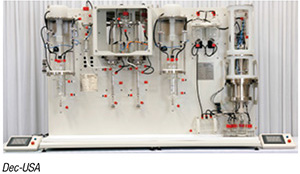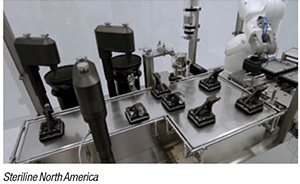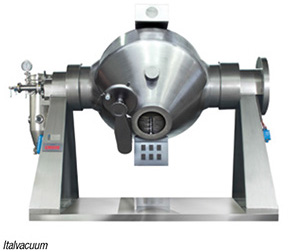![]() Interphex 2024 (www.interphex.com) — a global pharmaceutical and biotechnology event — will be held April 16–18 at the Jacob Javits Convention Center in New York City. The event will feature more than 450 exhibitors, as well as a dual-track conference program (focusing on sterile and non-sterile manufacturing) and several special networking events. This Show Preview highlights a few of the exhibitors who will be present at Interphex 2024.
Interphex 2024 (www.interphex.com) — a global pharmaceutical and biotechnology event — will be held April 16–18 at the Jacob Javits Convention Center in New York City. The event will feature more than 450 exhibitors, as well as a dual-track conference program (focusing on sterile and non-sterile manufacturing) and several special networking events. This Show Preview highlights a few of the exhibitors who will be present at Interphex 2024.
Flexibility is key with this new crystallization system
 This company has developed a new crystallization system (photo) that combines the flexibility and robustness of batch crystallization with efficiencies achieved from fully continuous processes. According to the company, the new system can complete crystallization tasks in around 60 min typically, with the option to operate in batch or semi-continuous mode, depending on process needs. Results are consistent and repeatable due to the system’s precise mixing, temperature-control and heat-transfer capabilities, as well as its high jacket-to-process-volume ratio. Its rapid, intense and homogeneous mixing ensures low crystal shear and allows for excellent particle-size control with minimal fines, resulting in a high-quality final product. The system is capable of handling material with a high solids content. With capacities ranging from 10 to 25 kg/h, the concept is suitable for a variety of production scales. Additional modules are available for larger throughputs. Stand 3629 — Dec-USA Inc., Brick Township, N.J.
This company has developed a new crystallization system (photo) that combines the flexibility and robustness of batch crystallization with efficiencies achieved from fully continuous processes. According to the company, the new system can complete crystallization tasks in around 60 min typically, with the option to operate in batch or semi-continuous mode, depending on process needs. Results are consistent and repeatable due to the system’s precise mixing, temperature-control and heat-transfer capabilities, as well as its high jacket-to-process-volume ratio. Its rapid, intense and homogeneous mixing ensures low crystal shear and allows for excellent particle-size control with minimal fines, resulting in a high-quality final product. The system is capable of handling material with a high solids content. With capacities ranging from 10 to 25 kg/h, the concept is suitable for a variety of production scales. Additional modules are available for larger throughputs. Stand 3629 — Dec-USA Inc., Brick Township, N.J.
This robotic vial-filling machine features “levitating” platform
 This company will be showcasing a robotic vial-filling machine (photo) that utilizes Planar Motor technology, a magnetically levitated transport system. The system includes a platform that levitates movers above a stainless-steel surface, providing 6 degrees of precise motion and zero friction. This allows for the transport of containers (vials, syringes, cartridges and so on) from station to station in the filling and closing operation without any mechanical components. Stand 2537 — Steriline North America, Inc., Bradenton, Fla.
This company will be showcasing a robotic vial-filling machine (photo) that utilizes Planar Motor technology, a magnetically levitated transport system. The system includes a platform that levitates movers above a stainless-steel surface, providing 6 degrees of precise motion and zero friction. This allows for the transport of containers (vials, syringes, cartridges and so on) from station to station in the filling and closing operation without any mechanical components. Stand 2537 — Steriline North America, Inc., Bradenton, Fla.
This vacuum dryer features built-in lump-breaking units
 The Criox System (photo) is a double-cone rotary vacuum dryer that includes lump-breaker units. Designed to treat wet or damp powders, such as active pharmaceutical ingredients (APIs), the Criox System has a bi-conical drying chamber, which can range in size from 12.5 up to 283 ft3. Electrical-motor-driven lump-breaker blades crush agglomerates in the batch, increasing the surface area of the product that is exposed to evaporation, improving the mixing effectiveness and drastically reducing drying times. Materials of construction include stainless-steel types 316L, 304, 904L and Alloy C-22. The system can also be equipped with this company’s Saurus piston-type vacuum pump, which can produce a vacuum level of 0.03 mbars. Stand 3236 — Italvacuum S.r.L., Turin, Italy
The Criox System (photo) is a double-cone rotary vacuum dryer that includes lump-breaker units. Designed to treat wet or damp powders, such as active pharmaceutical ingredients (APIs), the Criox System has a bi-conical drying chamber, which can range in size from 12.5 up to 283 ft3. Electrical-motor-driven lump-breaker blades crush agglomerates in the batch, increasing the surface area of the product that is exposed to evaporation, improving the mixing effectiveness and drastically reducing drying times. Materials of construction include stainless-steel types 316L, 304, 904L and Alloy C-22. The system can also be equipped with this company’s Saurus piston-type vacuum pump, which can produce a vacuum level of 0.03 mbars. Stand 3236 — Italvacuum S.r.L., Turin, Italy
Sublimation sensors help to optimize lyophilization processes
This company has developed a new sensor capable of monitoring the advance of the sublimation front in real time for freeze-drying processes. The single-use probe, containing five independent temperature sensors with wireless communication, is placed within the vial to monitor the advance of the sublimation front, which is key to optimizing the primary drying steps in lyophilization processes. The probes are coated with an FDA-approved material and are available in five different formats to fit into any vial size from 2R to 100R. A single system can hold up to 50 probes per freeze-drying batch. Without cables or batteries, the probes work via a patented wireless power-transmission technology. They have a reading interval of 1 min and can operate in temperatures from –60 to 60ºC. Stand 2453 — Telstar Life Sciences Solutions, Bensalem, Pa.
Mary Page Bailey